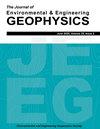基于人工神经网络的机载瞬变电磁法电阻率深度成像
IF 0.7
4区 工程技术
Q4 ENGINEERING, GEOLOGICAL
引用次数: 3
摘要
利用航空瞬变电磁法开发了一种人工神经网络,用于绘制地下地质电导率的分布。人工神经网络避免了复杂的电磁场公式推导,只需要输入函数和传递函数即可获得准电阻率图像。首先,从具有不同电阻率的均匀半空间模型的机载瞬变电磁响应中形成训练样本集,确定网络模型参数,包括飞行高度、时间常数和响应幅度。然后,基于准电阻率与机载瞬变电磁响应的映射关系,建立了双隐层反向传播(BP)神经网络。通过分析均方误差曲线,确定了BP神经网络的训练终止准则。利用训练好的BP神经网络对不同典型层状地电模型的机载瞬变电磁响应进行了解释,并与全时间视电阻率算法进行了比较。对比表明,BP神经网络方法的电阻率成像更接近模型的真实电阻率,对异常体的响应优于全时间视电阻率成像。最后,利用该成像技术对华阴测区机载瞬变法获取的野外数据进行了处理。用BP神经网络计算的拟电阻率深度剖面与实际地质情况吻合较好。本文章由计算机程序翻译,如有差异,请以英文原文为准。
Resistivity-depth Imaging with the Airborne Transient Electromagnetic Method Based on an Artificial Neural Network
We developed an artificial neural network to map the distribution of geologic conductivity in the earth subsurface using the airborne transient electromagnetic method. The artificial neural network avoids the need for complex derivations of electromagnetic field formulas and requires only input and transfer functions to obtain a quasi-resistivity image. First, training sample set from the airborne transient electromagnetic response of homogeneous half-space models with different resistivities was formed, and network model parameters, including the flight altitude, time constant, and response amplitude, were determined. Then, a double-hidden-layer back-propagation (BP) neural network was established based on the mapping relationship between quasi-resistivity and airborne transient electromagnetic response. By analyzing the mean square error curve, the training termination criterion of the BP neural network was determined. Next, the trained BP neural network was used to interpret the airborne transient electromagnetic responses of various typical layered geo-electric models, and the results were compared with that from the all-time apparent resistivity algorithm. The comparison indicated that the resistivity imaging from the BP neural network approach was much closer to the true resistivity of the model, and the response to anomalous bodies was better than that from an all-time apparent resistivity. Finally, this imaging technique was used to process field data acquired by employing the airborne transient method from the HuaYin survey area. Quasi-resistivity depth sections calculated with the BP neural network and the actual geological situation were in good.
求助全文
通过发布文献求助,成功后即可免费获取论文全文。
去求助
来源期刊

Journal of Environmental and Engineering Geophysics
地学-地球化学与地球物理
CiteScore
2.70
自引率
0.00%
发文量
13
审稿时长
6 months
期刊介绍:
The JEEG (ISSN 1083-1363) is the peer-reviewed journal of the Environmental and Engineering Geophysical Society (EEGS). JEEG welcomes manuscripts on new developments in near-surface geophysics applied to environmental, engineering, and mining issues, as well as novel near-surface geophysics case histories and descriptions of new hardware aimed at the near-surface geophysics community.
 求助内容:
求助内容: 应助结果提醒方式:
应助结果提醒方式:


